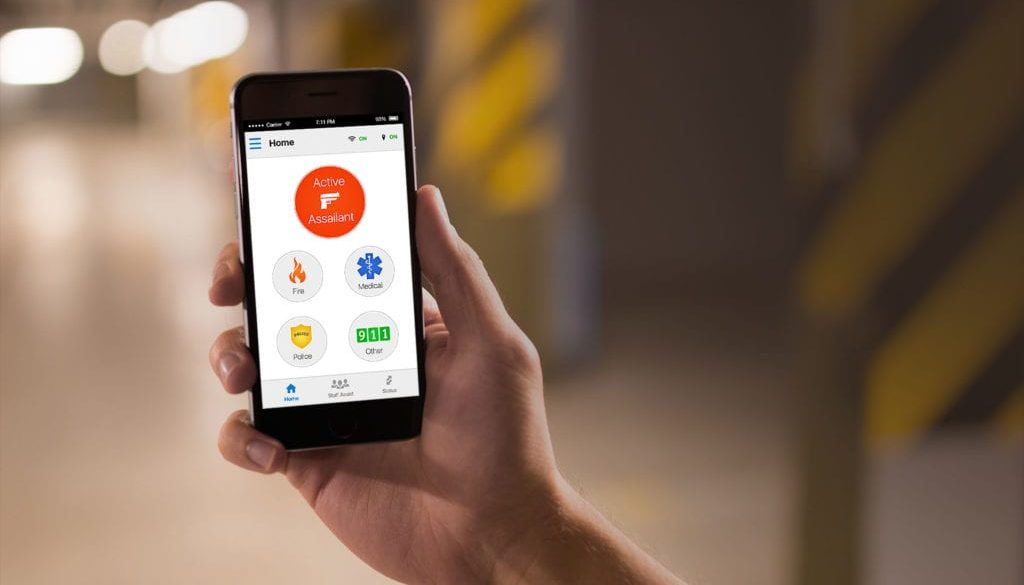Pourquoi chaque école devrait avoir un système d’application de bouton de panique
Updated 11/2022
A school panic button app is a communication system for schools designed to improve the outcome of crisis situations.
These apps enable faster responses and critical communication between administrators, staff, 9-1-1 call dispatchers and incident managers. Many universities and K-12 schools are adopting this cutting-edge technology to help keep their students and staff safe in the face of fires, severe weather, disease outbreaks, mental health crises and active shooter events.
In an emergency, every second matters. A person’s chances of surviving a heart attack decrease by 5.5 percent for every minute CPR is not administered. The majority of active shooter events are over before law enforcement personnel arrive. A fire can engulf a building in minutes.
In most crisis scenarios, the amount of time it takes to report and respond to an emergency can mean the difference between life and death. As such, schools must have a fast, reliable and effective emergency notification system designed to accelerate both internal and external/collaborative emergency response.
Limitations and disadvantages of physical buttons
Traditionally, panic buttons have required a physical installation at one or more locations, much like emergency boxes on college campuses. However, emergencies don’t always happen near these physical panic buttons.
Though these physical buttons have been an important mechanism in emergency management, there are some very obvious downsides to them now that technology is advancing.
For one, physical buttons need to be wired into an alert system. This becomes both labor-intensive and costly, and many schools might not have the budget allocated to allow for the installation of multiple buttons.
Secondly, a physical button acts as a “one and done” device. Unlike Rave Mobile Safety’s solutions for K-12 and higher education, a threatened student or teacher has no way of knowing whether their message was actually transmitted to the proper authorities. These physical emergency buttons are just that — buttons. Once pushed, they must either wait until help arrives or continue to press the button. This lack of two-way communication can make an already dangerous situation even worse.
Instead of installing a physical button, the best thing schools can do is purchase a cost-effective system such as the Rave Panic Button to allow all students, staff and teachers to access this lifeline from anywhere on campus.
What to look for in a school panic button
There are a few key factors you should consider when looking into adding a mobile panic button to your school’s safety plan:
Instant notification
When seconds mean the difference between life and death, it is critical to ensure that any panic button you employ will notify staff and emergency responders immediately. A school-wide alert should be sent out so that teachers and staff may respond to an emergency on their campuses, as well as alert local emergency response teams. Additionally, a good panic button will allow district officials to also alert parents of specific emergencies at school (i.e. lockdowns, active shooters, etc.).
Plus, with location-based alerting, administrators can label the boundaries of a school, which can enable messages to be sent out to all those within the geographical boundaries.
Integration with local emergency response systems
A panic button that simply calls 9-1-1 is no longer efficient enough to handle today’s emergencies, especially on school campuses. Unlike other panic apps, Rave Mobile Safety has created one that will ensure the most relevant data is quickly transmitted — without the student or staff’s need to give details. This may include caller location, emergency entry and exit points, floor plans and emergency contact info that first responders may need.
Multiple reporting options
In any emergency, it’s critical to have the correct personnel respond. A police officer likely won’t be as equipped to deal with an overdose or allergic reaction as an EMT would be. So the ability to alert the right emergency staff is important in a school’s panic button selection. You should look for systems that allow for various options, such as medical or mental health emergencies, missing persons, fires, active shooters, etc.
When can a panic button app be used?
A school panic button app system can accelerate both internal and external incident response to produce better outcomes. Best of all, it can be used in a variety of scenarios that affect today’s modern student population.
Active assailants
Active shooter events are frighteningly common in today’s school environments. The New York Times analyzed 433 active shooting events that occurred in the U.S. between 2000 and 2021 and found that 58 percent of them ended before the police arrived. Reducing the time it takes to report an event to staff, security officers and 9-1-1 lessens the time an assailant has to continue their attack unimpeded.
The sooner the school alert system is activated, the faster lockdown procedures can begin. The use of emergency communication apps during an active shooter event also creates a critical communication bridge between the initial reporter, onsite staff and incident managers. This bridge can accelerate emergency response and also increase situational awareness during the event.
Medical emergencies
App-enabled panic button systems can save student and staff lives during a critical medical emergency, such as a cardiac arrest, anaphylactic reaction or critical injury. By leveraging a school panic button app in such situations, a student and staff member can simultaneously notify 9-1-1, district administrators and onsite faculty from their mobile device.
One example of this comes from Benton, AR, where a student-athlete collapsed on the baseball field due to a heart attack. The head athletic trainer, TJ White, received a call reporting that a student had collapsed and was barely breathing. The coach on the scene activated the school panic button system, which alerted 9-1-1 and all medically trained onside staff immediately and simultaneously. By the time White reached the field moments after receiving the call, multiple coaches were on the scene and performing CPR, and first responders were starting to arrive.
Fires
When a fire starts, it can take just minutes for smoke to fill the air and a building to become completely engulfed in flames. Every second in a fire emergency is critical to the safety of everyone inside and in nearby buildings. A panic button app can rapidly alert school staff and 9-1-1, saving precious time and lowering the risk of casualties.
For example, if a fire erupts in a school’s chemistry lab or cafeteria, the staff member or student who witnesses the incident can use the panic button app to accelerate the evacuation process and reduce the time it takes for local firefighters to reach the scene.
School emergency communication apps can also be used to keep staff and district administrators up-to-date with developing threats such as wildfires in the local area. For example, 9-1-1 can use the app to alert district officials of a change in the fire’s direction, allowing them to quickly update a shelter-in-place order with evacuation instructions.
Critical reports
A student or staff member can use a school panic button app to call 9-1-1 in a wide range of crisis scenarios. Some examples include a missing student, threats or acts of violence against teachers or students, weapons activity on campus or the presence of alcohol or illegal drugs at school.
In one case, an elementary student in Albuquerque, NM, mistakenly brought marijuana-infused gummy bears to school and shared them with her classmates. Some of the students reportedly got sick while others displayed abnormal behavior including “the giggles.” With a mobile panic button system at their disposal, school teachers in a situation such as this could act quickly, providing key recipients with fast, accurate communication to get the students necessary medical attention and reduce the likelihood of rumors and misinformation.
Non-emergencies
Effective communication is vital even during non-emergency situations. A non-urgent incident, such as a minor injury during recess, may require aid from the school nurse but does not require an immediate response from 9-1-1 and law enforcement. Similarly, an app-based school notification system can be used to inform staff of local travel disruptions that may prevent them or their students from arriving at class on time.
Other examples of vital non-emergency communications include informing students of a classroom or schedule change, letting parents know that report cards have been delivered and reminding students of scheduled closures or in-service days.
The advantages of the Rave Panic Button
Think back to the time before cell phones, when all calls had to be made through a landline. Or possibly before that, when automatically dialing 9-1-1 was not an option, and a person had to go through an operator before they could contact the authorities.
Then, direct numbers came about. And a few decades later, cell phones were invented, allowing administration, students and teacher to call in an emergency from anywhere on campus.
The Rave Panic Button is merely the next iteration in safety protocol.
With heightened emergency management capabilities, the button will allow anyone to alert authorities, police, the fire department and other emergency management staff. With options for a medical emergency, fire, active shooter, police emergency and other emergency, contacting 911 can now be done with the push of a button.
This will save seconds worth of time in the event of an emergency — but those few seconds can mean the difference between life or death for dozens of children and adults.
Additionally, the button will automatically communicate with 911 operators to give an exact (or as close to) location, allowing response times to speed up drastically.
There are many panic buttons on the market, but the majority require the installation of a physical button somewhere on campus. The Rave Panic Button is a revolutionary tool that lives on an app, meaning that all students, staff and teachers will have access to it anywhere, anytime.





